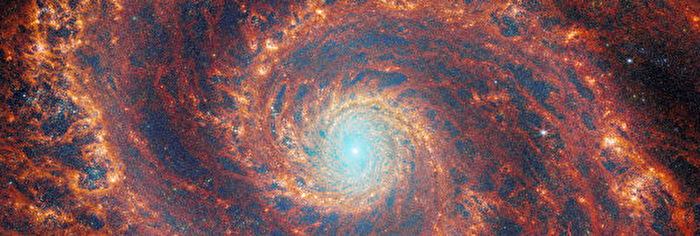“New Image of M51 Spiral Galaxy Captured by Webb Telescope Reveals Magnificent Spiral Arms”
Epoch Times, October 26, 2023 – The renowned James Webb Space Telescope has recently captured a stunning image of the M51 spiral galaxy. Situated approximately 25 million light-years away from Earth, M51 boasts grandly designed spiral arms, as reported by the European Space Agency (ESA). The image, obtained using data from the telescope’s Near Infrared Camera (NIRCam) and Mid-Infrared Instrument (MIRI), showcases the galaxy’s well-developed spiral arms in all their glory.
M51, also known as the Whirlpool Galaxy, resides in the constellation of the Hunting Dogs and is currently engaged in an intricate celestial dance with the nearby dwarf galaxy NGC 5195. This dynamic interaction has intrigued scientists, who have extensively studied the gravitational influence M51 exerts on its smaller neighbor. Experts believe that this interaction plays a significant role in the galaxy’s prominent and distinctive spiral arm formation.
The new image, obtained as part of the Feedback from Emerging Exoclusters (FEAST) series of observations, offers valuable insights into stellar feedback and star formation environments outside our own Milky Way galaxy. Stellar feedback, the energy released by stars into their birth environment, affects the rate of star formation and aids in constructing accurate star formation models.
The European Space Agency explains, “Stellar feedback has a huge impact on the galactic medium and creates a complex network of large numbers of bright nodes and cavernous black bubbles.”
In the image, deep red areas portray filaments of warm dust that permeate the galaxy’s medium. Rose-colored sections indicate the presence of complex molecules forming on dust grains, while orange and yellow regions showcase ionized gas resulting from recently formed star clusters.
Prior to the Webb telescope’s operational launch in 2022, other observatories like the Atacama Large Millimeter Array and the Hubble Space Telescope have provided glimpses into the star formation process. However, the Webb telescope is set to offer a new perspective on the early stages of star formation.
“For the first time, scientists have seen the birth of star clusters in galaxies outside the Milky Way and measured the time it takes for these stars to become doped with metals and clear their nearby gas clouds (these timescales vary from galaxy to galaxy),” ESA states.
Further observations and studies using the Webb telescope are anticipated to enhance our understanding of the regulation of the overall star formation cycle and metal enrichment processes within galaxies. Additionally, these findings could provide a clearer timeframe for the formation of planets and brown dwarfs, as the removal of gas and dust surrounding a newly formed star leaves no materials for planet formation.
As astronomers continue to explore the wonders of the universe, the James Webb Space Telescope stands as a remarkable tool in unraveling the mysteries of distant galaxies and shedding light on the intricate mechanisms governing the birth and evolution of stars.
